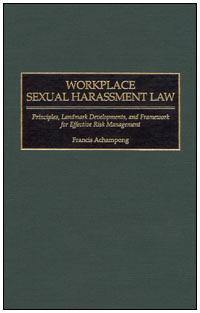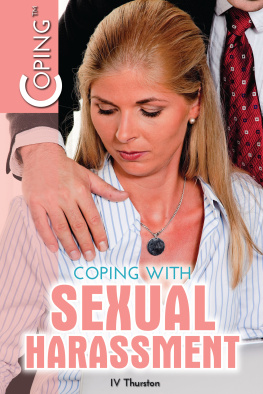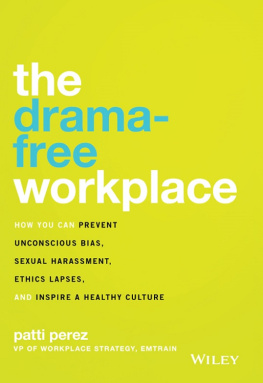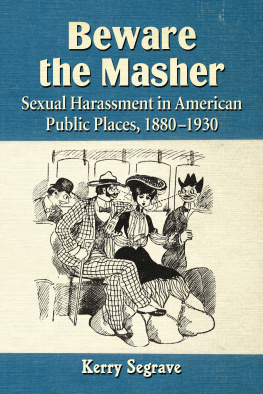Cover

| title | : | Workplace Sexual Harassment Law : Principles, Landmark Developments, and Framework for Effective Risk Management |
| author | : | Achampong, Francis. |
| publisher | : | Greenwood Publishing Group |
| isbn10 | asin | : | 1567203043 |
| print isbn13 | : | 9781567203042 |
| ebook isbn13 | : | 9780585385822 |
| language | : | English |
| subject | Sexual harassment--Law and legislation--United States, Sex discrimination in employment--Law and legislation--United States. |
| publication date | : | 1999 |
| lcc | : | KF3467.A93 1999eb |
| ddc | : | 344.7301/4133 |
| subject | : | Sexual harassment--Law and legislation--United States, Sex discrimination in employment--Law and legislation--United States. |
Page i
This page intentionally left blank.
Page ii
This page intentionally left blank.
Page iii
WORKPLACE SEXUAL HARASSMENT LAW
Principles, Landmark Developments, and Framework for Effective Risk Management
Francis Achampong

Page iv
Library of Congress Cataloging-in-Publication Data
Achampong, Francis, 1955
Workplace sexual harassment law : principles, landmark
developments, and framework for effective risk management / Francis
Achampong.
p. cm.
Includes bibliographical references and index.
ISBN 1567203043 (alk. paper)
1. Sexual harassmentLaw and legislationUnited States. 2. Sex
discrimination in employmentLaw and legislationUnited States.
I. Title.
KF3467.A93 1999
344.73014133dc21 9918647
British Library Cataloguing in Publication Data is available.
Copyright 1999 by Francis Achampong
All rights reserved. No portion of this book may be reproduced, by any process or technique, without the express written consent of the publisher.
Library of Congress Catalog Card Number: 9918647
ISBN: 1567203043
First published in 1999
Quorum Books, 88 Post Road West, Westport, CT 06881
An imprint of Greenwood Publishing Group, Inc.
www.quorumbooks.com
Printed in the United States of America

The paper used in this book complies with the Permanent Paper Standard issued by the National Information Standards Organization (Z39.481984).
10 9 8 7 6 5 4 3 2 1
Page v
To the Good Lord for Inspiration
Page vi
This page intentionally left blank.
Page vii
Contents
Preface | ix |
Part I | Sources, Evolution, and Principles of Workplace Sexual Harassment Law |
| Sources, Scope, and Coverage of Sexual Harassment Law | |
| Quid Pro Quo Sexual Harassment | |
| Hostile-Environment Sexual Harassment | |
Part II | Procedural Matters |
| Procedural Requirements in Sexual Harassment Cases | |
Part III | Landmark Developments in Sexual Harassment Law |
| Perspective for Viewing a Hostile Environment | |
| The Elimination of the Psychological-Harm Requirement | |
| Third-Party Harassment | |
| One Incident Can Create a Hostile Environment | |
| The Civil Rights Act of 1991 | |
| Same-Sex Sexual Harassment | |
| The Supreme Courts New Vicarious Liability Standard in Hostile-Environment Cases Involving Supervisors | |
Part IV | Legal Framework for Effective Risk Management |
| Effectively Managing the Sexual Harassment Liability Loss Exposure | |
Page viii
Appendixes |
A | Excerpts from EEOCs Guidelines on Discrimination Because of Sex | |
B | Excerpts from Title VII of the Civil Rights Act of 1964 | |
C | Excerpts from the Civil Rights Act of 1991 | |
D | Supreme Court Cases Discussed as Landmark Developments | |
E | Excerpts from the EEOC Compliance Manual | |
F | EEOC Policy Guidance on Current Issues of Sexual Harassment | |
Selected Bibliography | |
Index | |
Page ix
Preface
The incidence of sexual harassment in the workplace is well recognized and documented. Catharine MacKinnon spearheaded the drive for sexual harassment to be recognized as a legitimate cause of action under the sex discrimination provisions of the Civil Rights Act of 1964. Before the U.S. Supreme Court recognized sexual harassment as a legitimate form of sex discrimination prohibited by federal law in 1986 in its decision in Meritor Savings Bank v Vinson, many lower courts had struggled with the problematic issues raised by sexual harassment. Many lower courts had refused to recognize sexual harassment as a legitimate cause of action in sex discrimination, arguing that courts ought not to delve into interpretations of human behavior in the workplace because the area represented a slippery slope that would demand 4,000 federal judges instead of 400, or that it would encourage numerous other lawsuits. The reversal of these decisions on appeal was a recognition of the fact that sexual harassment is an unlawful practice that gives rise to a legitimate cause of action in employment law.
The Senate confirmation hearings held after the nomination of Clarence Thomas to the U.S. Supreme Court heightened the nations awareness of the problem of workplace sexual harassment. Although the highly partisan character of the proceedings did not allow it to become an educational experience for the nation by shedding light on what sexual harassment is and the types of conduct that constitute sexual harassment, the increased awareness it brought to the problem resulted in a well-documented astronomical increase in workplace sexual harassment lawsuits in the period immediately following the conclusion of the hearings.
Page x
In 1991, the year of the confirmation hearings, 6,892 sexual harassment lawsuits were filed nationwide. In 1993, only two years after the hearings, the number almost doubled to 12,537. In 1997, 15 thousand sexual harassment cases were reportedly filed. It was estimated that about 18 thousand sexual harassment cases would be filed in 1998. Recoveries by plaintiffs in sexual harassment litigation have also risen dramatically. The average amount awarded in the late 1980s was reported to be $181,847. It reportedly rose to $250,000 after compensatory and punitive damages became available to sexual harassment plaintiffs in 1991, and when legal costs were taken into account, the average cost of liability for sexual harassment in 1994 was reportedly $600,000. A study of 157 thousand state and federal personal injury cases shows that the median amount of compensatory damages awarded in discrimination and sexual harassment cases in 1997 was $250,000. The median amount of punitive damages awarded in sexual harassment cases alone was $100,000.
Next page








